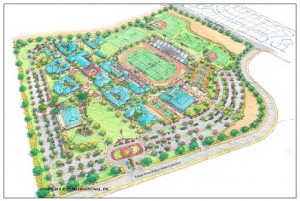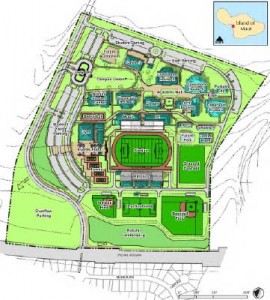Kihei H.S. Would Serve 1,650 Upon Completion
By Wendy Osher

Kihei High School conceptual image courtesy: Group 70 International Inc., State of Hawaii Draft EIS.
A 45-day public comment period has started on the Draft Environmental Impact Statement filed for the proposed Kihei High School in South Maui.
The State of Hawaii, Department of Education, proposes to develop the new high school on approximately 77 acres of undeveloped land, mauka of Piilani Highway.
The proposed site is located across from the Piilani Village residential subdivision in the Kihei-Makena region. It is bordered on the south by the Waipuilani Gulch, and on the north by the Kulanihakoi Gulch.
The Kïhei High School project is anticipated to be constructed in two phases, with the first phase expected to take two years to complete prior to the school opening projected for 2016. Phase I would allow for a capacity of 800 students.
Anticipated completion of Phase II construction would be approximately 10 years after the completion of Phase I, and would increase the school’s maximum enrollment to 1,650 students.
The proposed school would serve grades 9 to 12, with approximately 206 supporting faculty and staff.
The need for a high school in South Maui is being attributed in part to population growth of the region, coupled with the geographical separation from from existing crowded high schools in Central Maui.
Over the 10 year period ending in April of 2000, the county reported a 29% population growth to more than 128,000. During the same period, the Kihei-Makena region alone experienced a 49% growth to 22,870 people, according to the Draft EIS document.
The only school in South Maui currently serving students in grades 9-12 is the Kihei Charter School, which had 248 students enrolled in grades 9 through 12 this year.
The remaining 9-12 grade public school population in Kihei travels to Maui High or Baldwin High to attend school. This year, the report indicates that Maui High exceeded its design capacity by over 200 students, and Baldwin was just 50 students shy of maximum capacity.
Plans at the new Kihei High School call for the construction of buildings that meet or exceed the US Green Building Council Leadership in Energy and Environmental Design Silver certification.
In addition to educational buildings, the campus would also include a library and media arts center, auditorium, cafeteria, administration facility, athletic buildings, and supporting structures.
Outdoor athletic facilities may include outdoor play courts, athletic fields, a football/soccer/track stadium, and pool.
Access to the proposed high school campus is planned via a new access road off Piilani Highway. An extension of Kulanihakoi Street mauka of Piilani Highway would serve as the main campus access road.
Projected positive impacts include increased employment opportunities in the construction and education fields.
Potential impacts include minor loss of agricultural land, visual impacts to views from the Piilani Highway, and short-term air and noise impacts.
School operations would also increase local traffic, increase the demand for potable and non-potable water, and require extension of potable water and wastewater infrastructure.
According to the Draft EIS, the Kihei High School project requires land use entitlements including: a State Land Use District Boundary Amendment from Agricultural to Urban; an amendment to the County of Maui’s Kïhei-Makena Community Plan from Agriculture and Public/Quasi-Public to Public/Quasi-Public; a change in Maui County Zoning from Agricultural to P-1 Public/Quasi-Public; and final subdivision and consolidation approval.
The document states that it is a goal of the proposed development that the school will not only serve the enrolled youth, but be a center for the Kïhei community.
***Supporting information courtesy Draft EIS document, State of Hawaii.











